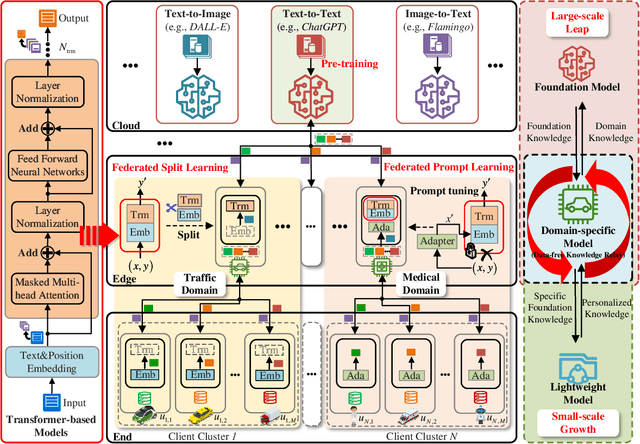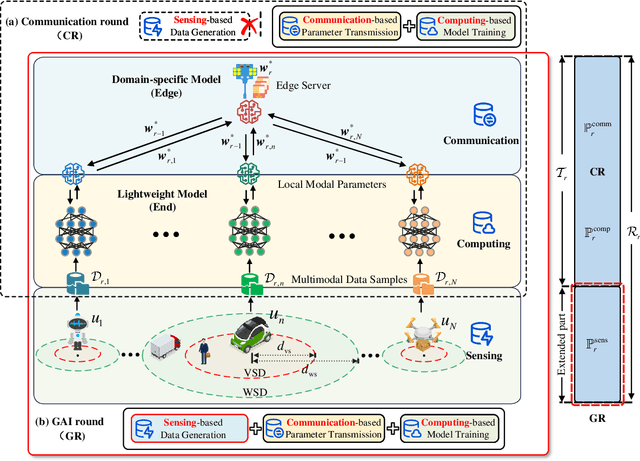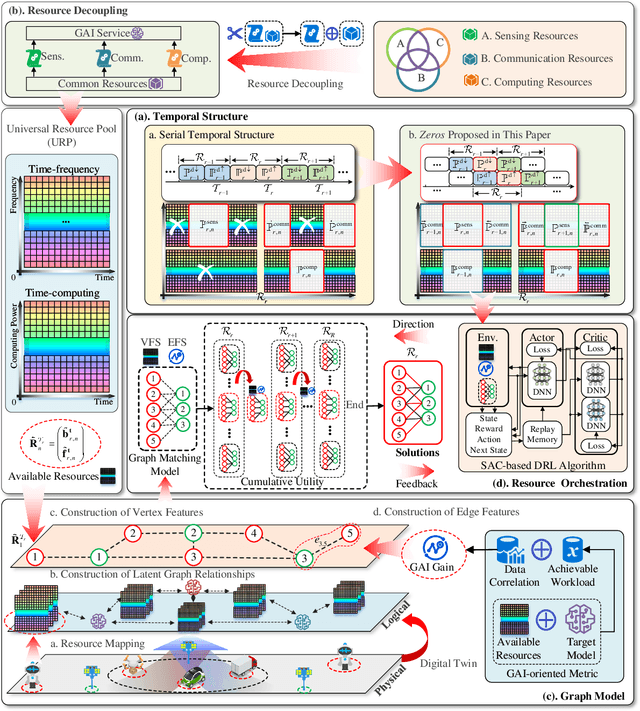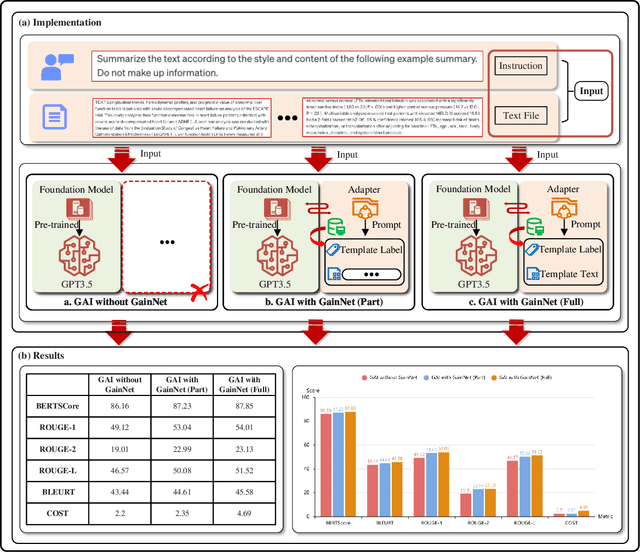Yifeng Zhao
GainNet: Coordinates the Odd Couple of Generative AI and 6G Networks
Jan 05, 2024



Abstract:The rapid expansion of AI-generated content (AIGC) reflects the iteration from assistive AI towards generative AI (GAI) with creativity. Meanwhile, the 6G networks will also evolve from the Internet-of-everything to the Internet-of-intelligence with hybrid heterogeneous network architectures. In the future, the interplay between GAI and the 6G will lead to new opportunities, where GAI can learn the knowledge of personalized data from the massive connected 6G end devices, while GAI's powerful generation ability can provide advanced network solutions for 6G network and provide 6G end devices with various AIGC services. However, they seem to be an odd couple, due to the contradiction of data and resources. To achieve a better-coordinated interplay between GAI and 6G, the GAI-native networks (GainNet), a GAI-oriented collaborative cloud-edge-end intelligence framework, is proposed in this paper. By deeply integrating GAI with 6G network design, GainNet realizes the positive closed-loop knowledge flow and sustainable-evolution GAI model optimization. On this basis, the GAI-oriented generic resource orchestration mechanism with integrated sensing, communication, and computing (GaiRom-ISCC) is proposed to guarantee the efficient operation of GainNet. Two simple case studies demonstrate the effectiveness and robustness of the proposed schemes. Finally, we envision the key challenges and future directions concerning the interplay between GAI models and 6G networks.
Integrated Sensing, Communication, and Computing for Cost-effective Multimodal Federated Perception
Nov 07, 2023Abstract:Federated learning (FL) is a classic paradigm of 6G edge intelligence (EI), which alleviates privacy leaks and high communication pressure caused by traditional centralized data processing in the artificial intelligence of things (AIoT). The implementation of multimodal federated perception (MFP) services involves three sub-processes, including sensing-based multimodal data generation, communication-based model transmission, and computing-based model training, ultimately relying on available underlying multi-domain physical resources such as time, frequency, and computing power. How to reasonably coordinate the multi-domain resources scheduling among sensing, communication, and computing, therefore, is crucial to the MFP networks. To address the above issues, this paper investigates service-oriented resource management with integrated sensing, communication, and computing (ISCC). With the incentive mechanism of the MFP service market, the resources management problem is redefined as a social welfare maximization problem, where the idea of "expanding resources" and "reducing costs" is used to improve learning performance gain and reduce resource costs. Experimental results demonstrate the effectiveness and robustness of the proposed resource scheduling mechanisms.
Characterization and Generation of 3D Realistic Geological Particles with Metaball Descriptor based on X-Ray Computed Tomography
Feb 05, 2023



Abstract:The morphology of geological particles is crucial in determining its granular characteristics and assembly responses. In this paper, Metaball-function based solutions are proposed for morphological characterization and generation of three-dimensional realistic particles according to the X-ray Computed Tomography (XRCT) images. For characterization, we develop a geometric-based Metaball-Imaging algorithm. This algorithm can capture the main contour of parental particles with a series of non-overlapping spheres and refine surface-texture details through gradient search. Four types of particles, hundreds of samples, are applied for evaluations. The result shows good matches on key morphological indicators(i.e., volume, surface area, sphericity, circularity, corey-shape factor, nominal diameter and surface-equivalent-sphere diameter), confirming its characterization precision. For generation, we propose the Metaball Variational Autoencoder. Assisted by deep neural networks, this method can generate 3D particles in Metaball form, while retaining coessential morphological features with parental particles. Additionally, this method allows for control over the generated shapes through an arithmetic pattern, enabling the generation of particles with specific shapes. Two sets of XRCT images different in sample number and geometric features are chosen as parental data. On each training set, one thousand particles are generated for validations. The generation fidelity is demonstrated through comparisons of morphologies and shape-feature distributions between generated and parental particles. Examples are also provided to demonstrate controllability on the generated shapes. With Metaball-based simulations frameworks previously proposed by the authors, these methods have the potential to provide valuable insights into the properties and behavior of actual geological particles.
A Data-driven feature selection and machine-learning model benchmark for the prediction of longitudinal dispersion coefficient
Jul 16, 2021



Abstract:Longitudinal Dispersion(LD) is the dominant process of scalar transport in natural streams. An accurate prediction on LD coefficient(Dl) can produce a performance leap in related simulation. The emerging machine learning(ML) techniques provide a self-adaptive tool for this problem. However, most of the existing studies utilize an unproved quaternion feature set, obtained through simple theoretical deduction. Few studies have put attention on its reliability and rationality. Besides, due to the lack of comparative comparison, the proper choice of ML models in different scenarios still remains unknown. In this study, the Feature Gradient selector was first adopted to distill the local optimal feature sets directly from multivariable data. Then, a global optimal feature set (the channel width, the flow velocity, the channel slope and the cross sectional area) was proposed through numerical comparison of the distilled local optimums in performance with representative ML models. The channel slope is identified to be the key parameter for the prediction of LDC. Further, we designed a weighted evaluation metric which enables comprehensive model comparison. With the simple linear model as the baseline, a benchmark of single and ensemble learning models was provided. Advantages and disadvantages of the methods involved were also discussed. Results show that the support vector machine has significantly better performance than other models. Decision tree is not suitable for this problem due to poor generalization ability. Notably, simple models show superiority over complicated model on this low-dimensional problem, for their better balance between regression and generalization.
A data-based comparative review and AI-driven symbolic model for longitudinal dispersion coefficient in natural streams
Jul 16, 2021



Abstract:A better understanding of dispersion in natural streams requires knowledge of longitudinal dispersion coefficient(LDC). Various methods have been proposed for predictions of LDC. Those studies can be grouped into three types: analytical, statistical and ML-driven researches(Implicit and explicit). However, a comprehensive evaluation of them is still lacking. In this paper, we first present an in-depth analysis of those methods and find out their defects. This is carried out on an extensive database composed of 660 samples of hydraulic and channel properties worldwide. The reliability and representativeness of utilized data are enhanced through the deployment of the Subset Selection of Maximum Dissimilarity(SSMD) for testing set selection and the Inter Quartile Range(IQR) for removal of the outlier. The evaluation reveals the rank of those methods as: ML-driven method > the statistical method > the analytical method. Whereas implicit ML-driven methods are black-boxes in nature, explicit ML-driven methods have more potential in prediction of LDC. Besides, overfitting is a universal problem in existing models. Those models also suffer from a fixed parameter combination. To establish an interpretable model for LDC prediction with higher performance, we then design a novel symbolic regression method called evolutionary symbolic regression network(ESRN). It is a combination of genetic algorithms and neural networks. Strategies are introduced to avoid overfitting and explore more parameter combinations. Results show that the ESRN model has superiorities over other existing symbolic models in performance. The proposed model is suitable for practical engineering problems due to its advantage in low requirement of parameters (only w and U* are required). It can provide convincing solutions for situations where the field test cannot be carried out or limited field information can be obtained.
 Add to Chrome
Add to Chrome Add to Firefox
Add to Firefox Add to Edge
Add to Edge